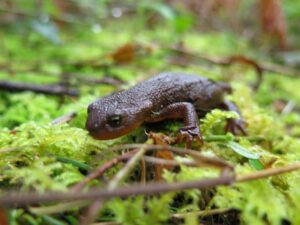— Kayla Seaforth, Land Bank Field Assistant
In lakes and ponds all across the lowland areas of the Pacific Northwest aquatic vegetation is emerging, but things are even more exciting below the water’s surface. It’s amphibian breeding season!
 One species that is currently engaged in their annual breeding ritual is the rough skinned newt (Taricha granulosa). These oft seen salamanders are bi-phasic in nature; they spend part of their life on land and migrate to still waters to breed. Humans are most likely to interact with the orange bellied cuties during their migrations to and from breeding pools from late winter to early spring and then again in late summer or early fall.
One species that is currently engaged in their annual breeding ritual is the rough skinned newt (Taricha granulosa). These oft seen salamanders are bi-phasic in nature; they spend part of their life on land and migrate to still waters to breed. Humans are most likely to interact with the orange bellied cuties during their migrations to and from breeding pools from late winter to early spring and then again in late summer or early fall.
Courtship between newts is initiated when a male climbs onto the back of a female and clasps her back with his feet. The newts remain intertwined anywhere from several hours to two days, at which point the male deposits his spermatophore at the bottom of the pool. The female picks up his packet of sperm with her cloaca and then deposits a fertilized egg on the underside of aquatic vegetation or leaves. These eggs are laid singly in rubbery, gelatinous envelops. Newt eggs hatch 3-4 weeks after they are laid and remain in a larval stage in the breeding pool for 4-5 months.
Newts are seldom bothered by predators that many other amphibians have to deal with due to their ability to produce a neurotoxin called tetrodotoxin, which both adult newts and their eggs contain. Herpetologists theorize that this potent toxin has co-evolved over time in an ‘arms race’ with the common garter snake, which can eat the toxic rough skin newt. Fish, ducks, bullfrogs, owls and humans have all died after eating rough-skinned newts (Jones, et al, 2006).
At one site on Orcas Island newts have been breeding since early February and have laid many eggs in a small pond. Stay tuned for updates as the eggs hatch and they turn from larvae to juvenile newts over the next several months!
Citation: Jones, Lawrence L. C., et al. Amphibians of the Pacific Northwest. Seattle Aubudon Society, 2006

